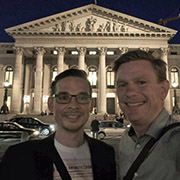Miroslav Srnka has composed moves for the Bavarian Radio Symphony Orchestra. Matthias Pintscher conducts the premiere on 8 May as part of “musica viva”.
In moves, his composition for the Bavarian Radio Symphony Orchestra, Miroslav Srnka plays with perception, with the experience of combination and contrast, both in the structural sense, and in particular in the (psycho-)acoustic sense. Thoughts on the limits of memory when listening and about the predictability of a soundstream led to the design of self-contained musical ‘moment forms’. In each of these an organic soundstream unfolds whose basis is a sophisticated, controlled structural web. This is generated from a mathematical curve, that vector description which was developed by the French mathematicians Pierre Bézier and Paul de Casteljau for car design.
Gestural and formal moments are shaped from this as independent units of movement, but corresponding with the “orchestral physiology”. The movements of the musicians are included as musical means, but they are not only seen as a means to the end of the tonal result which is sought after, but also inversely as physiological natural movements with the sound as a “secondary result”.
The two moves form the beginning of a series which is dedicated to similar phenomena. Srnka is interested in generating structures which break down and become absorbed in sound and movement. Finally, an extensive look at a performance situation results: at people as music makers with their entire movement physiology and at people as perceivers in their physical sphere. And not least, it deals with a fundamental musical question about the feeling for form and time: about the sensitive dividing line where rhythm ends and form begins.
Marie Luise Maintz
(translation: Elisabeth Robinson)
(from [t]akte 1/2015)



